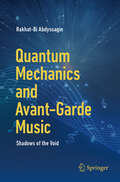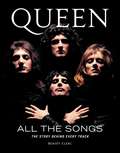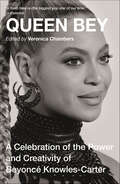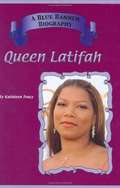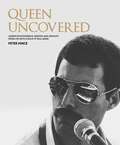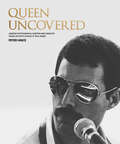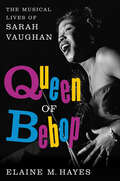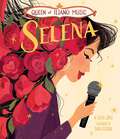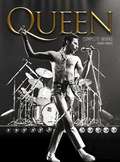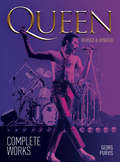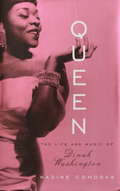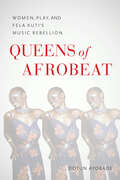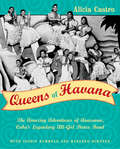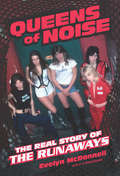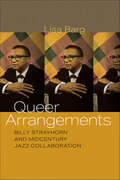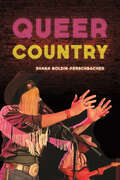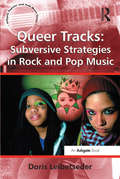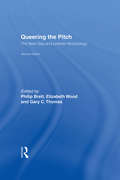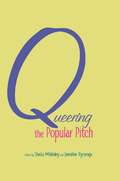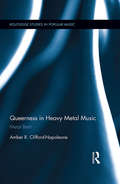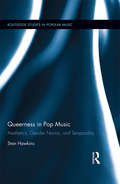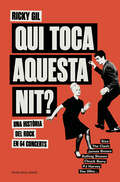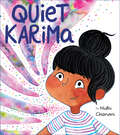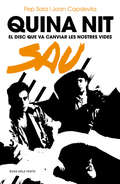- Table View
- List View
Quantum Mechanics and Avant-Garde Music: Shadows of the Void
by Rakhat-Bi Abdyssagin"Fascinating details and anecdotes accompany this engaging account of the emergence of dramatic new ideas and forms in music over the centuries..." David Politzer, winner of the 2004 Nobel Prize in Physics. "A thought-provoking, stimulating, and highly original exploration of deep metaphorical links between music and physics...Highly recommended." Prof. Ian Stewart FRS, author, What’s the Use? "An astonishing book!" Tristan Murail, composer and co-creator of the "spectral" technique. Have you ever wondered about the connection between Pauli's exclusion principle and Schoenberg's dodecaphony? Or the symphonic echoes of Heisenberg's uncertainty principle in the compositions of Stockhausen and Cage? This book not only poses these questions but skillfully uncovers the artistic answers, exploring interdisciplinary connections that bridge the gap between modern physics and contemporary music. Dive into philosophical discourses on time, witness the metamorphosis of Boolean algebra, bits, and qubits into musical notation, and discover the limitations of the 12-tone scale mirrored in the speed of light. The author's unique methodology offers a fresh perspective, linking the language of mathematics and physics to the creation of musical scores. This book transcends the boundaries of physics and music, revealing the inevitable fusion of modern physics and avant-garde music in the twentieth century. Through meticulous research, the author showcases the profound impact of revolutionary ideas such as quantum physics and relativity on all aspects of life and demonstrates that modern physics and contemporary music were born not out of chance—their emergence and development were inevitable events. Delving into the historical accounts, he explores the musical endeavors of great physicists like Max Planck and Albert Einstein, unraveling the quantum entanglement of physics mirrored in the extended techniques of contemporary music and unveiling the musical universe of Werner Heisenberg through captivating personal encounters with his descendants. Crafted for general readers and seasoned experts alike, the book maintains clarity and style, ensuring accessibility without sacrificing depth. This pioneering exploration not only draws connections between modern physics and music but also serves as a unique bridge for scientists, musicians, and the curious general audience. Requiring no formal background in physics or music, the book is a compelling read for those intrigued by the uncharted territories where science and art converge, offering a concise and illuminating journey into the shadows of the void.
Queen All the Songs: The Story Behind Every Track (All The Songs)
by Benoît ClercFilled with fascinating photographs (some rarely seen), and juicy behind-the-scenes details, Queen All the Songs details the unique recording history of the mega-bestselling and hugely influential rock band, album by album and track by track. <P><P>A lovingly thorough dissection of every album and every song ever released by the beloved rock group, Queen All the Songs follows Freddie, Brian, Roger, and John from their self-titled debut in 1973 through the untimely passing of Freddie, all the way up to their latest releases and the Oscar-winning film, Bohemian Rhapsody. The writing and recording process of each and every track is dissected, discussed, and analyzed by author Benoît Clerc, and page after page features fascinating and sometimes rarely seen images of the band. Queen All the Songs delves deep into the history and origins of the band and their music. This one-of-a-kind book draws upon decades of research and recounts the circumstances that led to the composition of every song, as well as the recording process, and the instruments used. Featuring hundreds of photographs, including rare black-and-white publicity stills, images of instruments used by the band, and engaging shots of the musicians in-studio, Queen All the Songs is the must-have book for any true fan of classic rock.
Queen Bey: A Celebration of the Power and Creativity of Beyoncé Knowles-Carter
by Veronica ChambersFEATURED IN: The New York Times Book Review ("New and Noteworthy") •Essence • Newsweek•People • Bustle • PopSugar • Refinery 29 • HelloGiggles' • PureWow • Newsday• AMNewYorkThe Ultimate Beyoncé Collectible"Beyoncé fans will eat it up." —People"You don't need to be in the Beyhive to appreciate Queen Bey...Voices including culture critic Luvvie Ajayi and actress and producer Lena Waithe give us a fresh take on Beyoncé, who's arguably the biggest pop star of our time." —EssenceBeyoncé. Her name conjures more than music, it has come to be synonymous with beauty, glamour, power, creativity, love, and romance. Her performances are legendary, her album releases events. She is not even forty but she has already rewritten the Beyoncé playbook more than half a dozen times. She is consistently provocative, political and surprising. As a solo artist, she has sold more than 100 million records. She has won 22 Grammys and is the most-nominated woman artist in the history of Grammy awards. Her 2018 performance at Coachella wowed the world. The New York Times wrote: "There's not likely to be a more meaningful, absorbing, forceful and radical performance by an American musician this year or any year soon." Artist, business woman, mother, daughter, sister, wife, black feminist, Queen Bey is endlessly fascinating. Queen Bey features a diverse range of voices, from star academics to outspoken cultural critics to Hollywood and music stars. Essays include:"What Might a Black Girl Be in This World," an introduction by Veronica Chambers"Beychella is Proof That Beyoncé is the Greatest Performer Alive. I’m Not Arguing." by Luvvie Ajayi"On the Journey Together," by Lena Waithe"What Beyoncé Means to Everyone," by Meredith Broussard with visualizations by Andrew Harvard and Juan Carlos Mora"Jay-Z's Apology to Beyoncé Isn't Just Celebrity Gossip — It's a Political Act" by Brittney Cooper"All Her Single Ladies" by Kid Fury "The Elevator" by Ylonda Gault "The Art of Being Beyoncé" by Maria Brito"Getting, Giving and Leaving" by Melissa Harris Perry and Mankaprr Conteh"Beyoncé the Brave" by Reshma Saujani"Living into the Lemonade: Redefining Black Women’s Spirituality in the Age of Beyoncé" by Candice Benbow"Beyoncé’s Radical Ways" by Carmen Perez"Finding la Reina in Queen Bey" by Isabel Gonzalez Whitaker"Beyoncé, Influencer" by Elodie Maillet Storm"The King of Pop and the Queen of Everything" by Michael Eric Dyson"Style So Sacred" by Edward Enninful"The Beauty of Beyoncé" by Fatima Robinson "Because Beyoncé." by Ebro Darden"King Bey" by Treva B. Lindsey"Meridonial: Beyoncé’s Southern Roots and References" by Robin M. Boylorn"B & V: A Love Letter" by Caroline Clarke
Queen Latifah
by Kathleen TracyQueen Latifah was a tomboy in her New Jersey city. But now, she's a rapper, (her CD's have sold millions), she is an actress, (She was nominated for an academy award, the first hip-hop artist to be nominated), and so much more. this children's biography highlights her career moves, from rap to acting, and what she hopes to accomplish in the future.
Queen Uncovered: Unseen Photographs, Rarities and Insights From Life With A Rock 'n' Roll Band
by Peter HincePeter Hince spent 13 years as head roadie for Queen. His collection of photographs and ephemera from the band&’s personal and public moments will finally see the light of day for the first time. It&’s a unique photographic record of one of the most celebrated rock bands of all time. From concerts in Munich to Japan, Hince follows Queen from studio to street to stage. Facsimiles of handwritten notes from recording sessions, photos of the band in the studio, images of cassettes given to Hince to debut at clubs, Freddie Mercury with and without a mustache . . . the list goes on. Along with many candid moments are great photos of the various items collected from more than a decade of tours: backstage passes, matchbooks, set lists, and more.
Queen Uncovered: Unseen photographs, rarities and insights from life with a rock 'n' roll band
by Peter HinceFor 13 years, Peter Hince lived the rock 'n' roll dream. As head roadie for Queen he had a front row seat and backstage pass to some of the greatest moments in music.Now, he is opening up his incredible archive and sharing hundreds of photographs and mementoes – many never seen before – as well as stories and memories from life inside rock 'n' roll history.Queen Uncovered is packed with images and ephemera from this truly unique collection, covering life on the road and in the studio, backstage and on-stage, relaxing at parties, filming iconic music videos and much more besides.
Queen of Bebop: The Musical Lives of Sarah Vaughan
by Elaine M. HayesPublishers Weekly Best Book of 2017Washington Post Best Book of 2017Amazon Editors' Top 100 Pick of the YearAmazon Best Humor and Entertainment Pick of the YearBooklist Top Ten Arts BookQueen of Bebop brilliantly chronicles the life of jazz singer Sarah Vaughan, one of the most influential and innovative musicians of the twentieth century and a pioneer of women’s and civil rightsSarah Vaughan, a pivotal figure in the formation of bebop, influenced a broad array of singers who followed in her wake, yet the breadth and depth of her impact—not just as an artist, but also as an African-American woman—remain overlooked. Drawing from a wealth of sources as well as on exclusive interviews with Vaughan’s friends and former colleagues, Queen of Bebop unravels the many myths and misunderstandings that have surrounded Vaughan while offering insights into this notoriously private woman, her creative process, and, ultimately, her genius. Hayes deftly traces the influence that Vaughan’s singing had on the perception and appreciation of vocalists—not to mention women—in jazz. She reveals how, in the late 1940s and early 1950s, Vaughan helped desegregate American airwaves, opening doors for future African-American artists seeking mainstream success, while also setting the stage for the civil rights activism of the 1960s and 1970s. She follows Vaughan from her hometown of Newark, New Jersey, and her first performances at the Apollo, to the Waldorf Astoria and on to the world stage, breathing life into a thrilling time in American music nearly lost to us today.Equal parts biography, criticism, and good old-fashioned American success story, Queen of Bebop is the definitive biography of a hugely influential artist. This absorbing and sensitive treatment of a singular personality updates and corrects the historical record on Vaughan and elevates her status as a jazz great.
Queen of Tejano Music: Selena
by Silvia LópezThis moving and impassioned picture book about the iconic Queen of Tejano music, Selena Quintanilla, that will embolden young readers to find their passion and make the impossible, possible!Selena Quintanilla's music career began at the age of nine when she started singing in her family's band. She went from using a hairbrush as a microphone to traveling from town to town to play gigs. But Selena faced a challenge: People said that she would never make it in Tejano music, which was dominated by male performers. Selena was determined to prove them wrong.Born and raised in Texas, Selena didn't know how to speak Spanish, but with the help of her dad, she learned to sing it. With songs written and composed by her older brother and the fun dance steps Selena created, her band, Selena Y Los Dinos, rose to stardom! A true trailblazer, her success in Tejano music and her crossover into mainstream American music opened the door for other Latinx entertainers, and she became an inspiration for Latina girls everywhere.
Queen: Complete Works
by Georg PurvisMixing and clashing an outrageously eclectic set of influences-the close harmonies of the Beatles, the guitar pyrotechnics of Jimi Hendrix, the heavy sound of Led Zeppelin, and the glamour of David Bowie-Queen found a winning formula by channeling this strange cocktail through its charismatic frontman, Freddie Mercury. More than a decade after Mercury's death, Queen's fan base continues to grow. This meticulous, session-by-session, album-by-album, tour-by-tour chronicle of the band is the book that Queen fans have been waiting for.
Queen: Complete Works (revised and updated)
by Georg PurvisClashing together outrageous musical influences, and extravagant visual imagery, Queen's place in history as the greatest glam band of them all is rock solid.Their fan base continues to grow, over 25 years on from the death of Freddie Mercury, Queen's flamboyant, unforgettable front man. Georg Purvis's meticulous, session-by-session, song-by-song, album-by-album, tour-by-tour record of the band's progress is the complete reference source that Queen fans have been waiting for. If you love the Champions of Rock, it's all here:The Band - detailed insights into Freddie Mercury, Brian May, Roger Taylor and John Deacon including bands the members formed outside of Queen and solo endeavours The Albums - detailed production history and analysis of every album, including solo releasesThe Sessions - In depth coverage from the early days via A Night at The Opera all the way to Made in HeavenThe Songs - hundreds of individual entries on all the famous recordings, as well as obscure, unreleased raritiesThe Tours - set-lists and histories of every Queen and Queen-related live show including Queen + Adam LambertThe Videos - a complete guide to Queen's groundbreaking video workThe Movies - Flash Gordon, Highlander and 2018's Bohemian Rhapsody biopic Plus - the reunion shows with Paul Rodgers, Adam Lambert, the radio sessions, the costumes, the parties and much, much more...
Queen: The Life and Music of Dinah Washington
by Nadine CohodasIn this biography of jazz singer Dinah Washington (1924-1963), Cohodas traces her life as a child in Tuscaloosa, Alabama, the beginnings of her career when she sang with Lionel Hampton's band, recordings and songs, and her performances with her trio, as a soloist, and other groups. A discography is provided. Cohodas is the author of other books on music and politics. Annotation ©2006 Book News, Inc. , Portland, OR (booknews. com)
Queens of Afrobeat: Women, Play, and Fela Kuti's Music Rebellion
by Dotun AyobadeIn Queens of Afrobeat, the women of Afrobeat music—a unique blend of jazz, soul, highlife, and West African rhythms—are finally given the recognition they deserve. This extensive study takes a multifaceted view of the storied lives of the women behind Fela Kuti's activist music.Dotun Ayobade's wide-ranging research pulls from interviews with surviving queens, ethnographic narratives, the exploration of newspaper archives, and close readings of album covers, photographs, and promotional materials to help us see and understand the women who surrounded Fela Kuti on stage and in everyday life. Not only were these artists crucial performers and backup singers for Kuti's most important compositions, they also played key roles in his activism and campaigns of social protest against the Nigerian government in the 1970s. Drawing on previously untapped material, Queens of Afrobeat weaves together an intricate narrative of women's participation in popular music. The stories of these remarkable women transform and uniquely personalize our understanding of the politics and performance of one of the major modern musical traditions in Africa.
Queens of Havana: The Amazing Adventures of Anacaona, Cuba's Legendary All-Girl Dance Band
by Alicia Castro Ingrid Kummels Manfred SchäferThe 1930s saw Havana undergoing a seismic cultural renaissance. At night in the aires libres (open air cafes), tourists and foreign investors rubbed shoulders with the likes of Ernest Hemingway as they sipped cocktails, cavorted with Cuban beauties, and listened to suggestive melodies from Havana’s unmatched musical community. It was rare for women to attend, and unheard of for them to perform. But when greengrocer Matias Castro, father of thirteen, goes bankrupt, his eldest daughter has the idea of starting an all-girl band with her sisters an outrageous idea in macho Cuba, but a surefire money maker. Every evening, as the rum began to flow, Anacaona took to the stage to let rip jazz, mambo, rumba, and cha-cha their infectious rhythms, cheeky lyrics, and sheer sex appeal conquer their audiences’ hearts. In this evocative memoir, saxophonist Alicia Castro, now in her eighties, looks back on the Havana of yesterday and the dazzling career of the dance band, from concerts in Paris and New York, to appearances with Dizzy Gillespie, Celia Cruz, Duke Ellington, and Cab Calloway. Spirited and conversational, Queens of Havana is a touching piece of hidden history guaranteed to set your heart racing and get your toes tapping!
Queens of Noise: The Real Story of the Runaways
by Evelyn McdonnellIn four years the teenage members of the Runaways did what no other group of female rock musicians before them could: they released four albums for a major label and toured the world. The Runaways busted down doors for every girl band that followed. Joan Jett, Sandy West, Cherrie Currie, lead guitarist Lita Ford, and bassists Jackie Fox and Vicky Blue were pre-punk bandits, fostering revolution girl style decades before that became a riot grrrl catchphrase.The story of the Runaways has never been told in its entirety. Drawing on interviews with most of this seminal rock band's former members as well as controversial manager Kim Fowley, Queens of Noise will look beyond the lurid voyeuristic appeal of a sex-drugs-rock 'n' roll saga to give the band its place in musical, feminist, and cultural history.
Queer Arrangements: Billy Strayhorn and Midcentury Jazz Collaboration
by Lisa BargWinner of the 2024 Philip Brett Award, sponsored by the LGBTQ Study Group of the American Musicological Society (AMS)The legacy of Black queer composer, arranger, and pianist Billy Strayhorn (1915–1967) hovers at the edge of canonical jazz narratives. Queer Arrangements explores the ways in which Strayhorn's identity as an openly gay Black jazz musician shaped his career, including the creative roles he could assume and the dynamics between himself and his collaborators, most famously Duke Ellington, but also iconic singers such as Lena Horne and Ella Fitzgerald. This new portrait of Strayhorn combines critical, historically-situated close readings of selected recordings, scores, and performances with biography and cultural theory to pursue alternative interpretive jazz possibilities, Black queer historical routes, and sounds. By looking at jazz history through the instrument(s) of Strayhorn's queer arrangements, this book sheds new light on his music and on jazz collaboration at midcentury.
Queer Country (Music in American Life)
by Shana Goldin-PerschbacherThough frequently ignored by the music mainstream, queer and transgender country and Americana artists have made essential contributions as musicians, performers, songwriters, and producers. Queer Country blends ethnographic research with analysis and history to provide the first in-depth study of these artists and their work. Shana Goldin-Perschbacher delves into the careers of well-known lesbian artists like k.d. lang and Amy Ray and examines the unlikely success of singer-songwriter Patrick Haggerty, who found fame forty years after releasing the first out gay country album. She also focuses on later figures like nonbinary transgender musician Rae Spoon and renowned drag queen country artist Trixie Mattel; and on recent breakthrough artists like Orville Peck, Amythyst Kiah, and chart-topping Grammy-winning phenomenon Lil Nas X. Many of these musicians place gender and sexuality front and center even as it complicates their careers. But their ongoing efforts have widened the circle of country/Americana by cultivating new audiences eager to connect with the artists’ expansive music and personal identities. Detailed and one-of-a-kind, Queer Country reinterprets country and Americana music through the lives and work of artists forced to the margins of the genre's history.
Queer Tracks: Subversive Strategies In Rock And Pop Music (Ashgate Popular and Folk Music Series)
by Doris LeibetsederQueer Tracks describes motifs in popular music that deviate from heterosexual orientation, the binary gender system and fixed identities. This exciting cutting-edge work deals with the key concepts of current gender politics and queer theory in rock and pop music, including irony, parody, camp, mask/masquerade, mimesis/mimicry, cyborg, transsexuality, and dildo. Based on a constructivist concept of gender, Leibetseder asks: ’Which queer-feminist strategies are used in rock and pop music?’ ’How do they function?’ ’Where do they occur?’ Leibetseder's methodological process is to discover subversive strategies in queer theory, which are also used in rock and pop music, without assuming that these tactics were first invented in theory. Furthermore, this book explains where exactly the subversiveness is situated in those strategies and in popular music. With the help of a new kind of knowledge transfer the author combines sociological and cultural theories with practical examples of rock and pop music. The subversive character of these queer motifs is shown in the work of contemporary popular musicians and is at the same time related to classical discourses of the humanities. Queer Tracks is a revised translation of Queere Tracks. Subversive Strategien in Rock- und Popmusik, originally published in German.
Queer Voices
by Freya Jarman-IvensThis book argues that there are some important implications of the role the voice plays in popular music when thinking about processes of identification. The central thesis is that the voice in popular music is potentially uncanny (Freud's unheimlich), and that this may invite or guard against identification by the listener.
Queering the Pitch: The New Gay And Lesbian Musicology
by Elizabeth Wood Philip Brett Gary C. ThomasWhen the first edition of Queering the Pitch was published in early 1994, it was immediately hailed as a landmark and defining work in the new field of Gay Musicology. In light of the explosion of Gay Musicology since 1994, a new edition of Queering the Pitch is timely and needed. In this new work, the editors are including a landmark essay by Philip Brett on Gay Musicology, its history and scope. The essay itself has become a cause celebre, and this will be its first full appearance in print. Along with this new historical essay, the editors are contributing a new introduction that outlines the changes that have occurred over the last decade as Gay Musicology has grown.
Queering the Popular Pitch
by Jennifer Rycenga Sheila WhiteleyQueering the Popular Pitch is a new collection of 19 essays that situate queering within the discourse of sex and sexuality in relation to popular music. This investigation addresses the changing debates within gay, lesbian and queer discourse in relation to the dissemination of musical texts -performance, cultural production and sexual meaning - situating music within the broader patterns of culture that it both mirrors and actively reproduces. The collection is divided into four parts:queering borders queer spaces hidden histories queer thoughts, mixed media. Queering the Popular Pitch will appeal to students of popular music, Gay and Lesbian studies. With case studies and essays by leading popular music scholars it provides insightful discourse in a growing field of musicological research.
Queerness in Heavy Metal Music: Metal Bent (Routledge Studies in Popular Music)
by Amber R. Clifford-NapoleoneWhile the growing field of scholarship on heavy metal music and its subcultures has produced excellent work on the sounds, scenes, and histories of heavy metal around the world, few works have included a study of gender and sexuality. This cutting-edge volume focuses on queer fans, performers, and spaces within the heavy metal sphere, and demonstrates the importance, pervasiveness, and subcultural significance of queerness to the heavy metal ethos. Heavy metal scholarship has until recently focused almost solely on the roles of heterosexual hypermasculinity and hyperfemininity in fans and performers. The dependence on that narrow dichotomy has limited heavy metal scholarship, resulting in poorly critiqued discussions of gender and sexuality that serve only to underpin the popular imagining of heavy metal as violent, homophobic and inherently masculine. This book queers heavy metal studies, bringing discussions of gender and sexuality in heavy metal out of that poorly theorized dichotomy. In this interdisciplinary work, the author connects new and existing scholarship with a strong ethnographic study of heavy metal’s self-identified queer performers and fans in their own words, thus giving them a voice and offering an original and ground-breaking addition to scholarship on popular music, rock, and queer studies.
Queerness in Pop Music: Aesthetics, Gender Norms, and Temporality (Routledge Studies in Popular Music #10)
by Stan HawkinsThis book investigates the phenomenon of queering in popular music and video, interpreting the music of numerous pop artists, styles, and idioms. The focus falls on artists, such as Lady Gaga, Madonna, Boy George, Diana Ross, Rufus Wainwright, David Bowie, Azealia Banks, Zebra Katz, Freddie Mercury, the Pet Shop Boys, George Michael, and many others. Hawkins builds his concept of queerness upon existing theories of opacity and temporality, which involves a creative interdisciplinary approach to musical interpretation. He advocates a model of analysis that involves both temporal-specific listening and biographic-oriented viewing. Music analysis is woven into this, illuminating aspects of parody, nostalgia, camp, naivety, masquerade, irony, and mimesis in pop music. One of the principal aims is to uncover the subversive strategies of pop artists through a wide range of audiovisual texts that situate the debates on gender and sexuality within an aesthetic context that is highly stylized and ritualized. Queerness in Pop Music also addresses the playfulness of much pop music, offering insights into how discourses of resistance are mediated through pleasure. Given that pop artists, songwriters, producers, directors, choreographers, and engineers all contribute to the final composite of the pop recording, it is argued that the staging of any pop act is a collective project. The implications of this are addressed through structures of gender, ethnicity, nationality, class, and sexuality. Ultimately, Hawkins contends that queerness is a performative force that connotes futurity and utopian promise.
Qui toca aquesta nit?: Una història del rock en 64 concerts
by Ricky Gil GinerViure la música en directe és una experiència brutal. Sortir de casa, travessar la ciutat, arribar al local i saludar els amics. Barrejar-se entre la gent, els llums que s'apaguen, esperar la primera nota, compartir l'excitació. Aquell moment indescriptible en què toquen la teva cançó. Ricky Gil ha viscut molts concerts en primera persona, a dalt de l'escenari amb les seves bandes o com a espectador d'algunes de les figures més monumentals del rock, del blues, del soul, del punk i d'altres gèneres. I a Qui toca aquesta nit? ens convida a reviure'ls amb un gran talent narratiu. Sisa i Melodrama, Ramones, Bob Dylan, Bruce Springsteen, Curtis Mayfield, Gato Pérez, Elvis Costello, PJ Harvey, Toots and the Maytals, Sex Pistols, Els Surfing Sirles, Neil Young o The Pretenders són alguns dels grans noms que protagonitzen aquestes pàgines. Seixanta-quatre concerts des del 1977 fins avui, a sales mítiques barcelonines (del Zeleste a l'Apolo, de la Monumental al Palau d'Esports, del Bikini a l'Studio 54) i també a Londres o a Nova York.«La música que vam estimar s'esvaneix a cada moment, escriu Ricky Gil, però queden per sempre a la memòria aquells instants en què "després de sortir de casa i just abans d'arrancar la Lambretta, tornàvem a preguntar: Qui toca aquesta nit?».
Quiet Karima
by Nidhi ChananiEven if you&’re quiet, you can still be loud!Without silence, there is no music.Karima is quiet. She&’d prefer to listen to the world than to talk. In fact, she listens to the chirps, thuds, and squeaks all around her, and in everything she hears a melody or a beat. As she journeys to her music class, she soaks up all the sounds along the way, until she is ready to perform a song that is uniquely her own.Celebrated author of Pashmina Nidhi Chanani has created a lyrical celebration of introverts everywhere as Quiet Karima shows there are many ways to use your voice.
Quina nit: El disc que va canviar les nostres vides
by Pep Sala Joan CapdevilaEn motiu del 30è aniversari de la publicació del mític disc «Quina nit», els Sau ens expliquen totes les anècdotes, curiositats de concerts inoblidables i moments irrepetibles. Un dels grups pioners del rock català i de més èxit dels anys 90, deu discos i un munt de cançons que han aconseguit arribar fins els nostres dies. Quina nit és el disc que catapulta Sau a l'èxit al 1990. ha venut més de 100.000 còpies i te un himne, El Boig per tu, la cançó més radiada de la història del nostre país. En el 30è aniversari de la seva publicació, la banda SAU30 ho celebra amb el seu públic amb un concert "Quina nit, Quina lluna, que s'emetrà a TV3 al desembre, una gira que comença al gener i un llibre on Pep Sala i en Joan Capdevila, ens expliquen què va passar durant la creació, enregistrament, promoció i gira d'aquest disc únic. Un munt d'anècdotes i curiositats, que ens transportaran als 90, a concerts inoblidables i moments irrepetibles. Un llibre per recordar Sau, les seves cançons i recordar-nos a nosaltres. Pep Sala és un dels músics més influents de la música catalana. Pianista, guitarrista, compositor, arranjador, lletrista i productor, a Sau, Pep Sala & La Banda del Bar i en solitari. Ha col·laborat amb artistes d'arreu del món com Robbie Robertson, Jackson Browne, Steve Hogarth, Kathy Chiavolla, Joan Manel Serrat, Luz Casal, Josep Carreras, Sergio Dalma, Shakira, Dyango. Joan Capdevila, considerat el tercer Sau, va ser colletrista, manager i cofundador de la banda.
